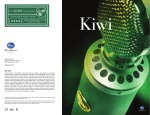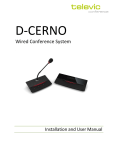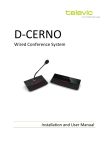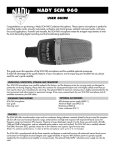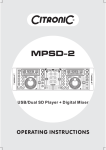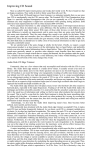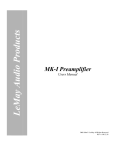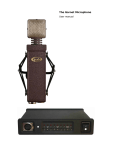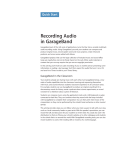Download Bottle Rocket Stage Two Manual
Transcript
TechnicAl ReAdout Acoustical operating principal: Pressure gradient or pure pressure (depending on capsule) Sensitivity (1kHz into 2.5kΩ): 50mV/Pa (+/−10mV depending on capsule) Rated impedance: 50Ω Rated load impedance: Not less than 1kΩ Noise level a-weighted (iec 651): Not more than 9dBV– 14dBV (depending on capsule) Max output (1% thd into 2.5kΩ): +28dBV = 25.11 Vrms Max spl (1.0% thd into 2.5kΩ): 139dB Dynamic range (2.5kΩ load): 130dB Power supply: External Powerstream™ unit Current draw: Heater (6V DC) 300mA, Plate(120V) 5mA– Typical WARRANTY Blue Microphones warrants its hardware product against defects in materials and workmanship for a period of THREE (3) YEARS from the date of original retail purchase, provided the purchase was made from an authorized Blue Microphones dealer. This warranty is void if the equipment is altered, misused, mishandled, maladjusted, or is serviced by any parties not authorized by Blue Microphones The warranty does not include transportation costs incurred because of the need for service unless arranged for in advance. Blue Microphones reserves the right to make changes in design and improve upon its products without obligation to install these improvements in any of its products previously manufactured. For warranty service or for a copy of Blue’s Warranty Policy including a complete list of exclusions and limitations, contact Blue at 818-879-5200. B O T T L E Frequency response: 20Hz – 20kHz ClAss A TuBE Microphone Directional pattern: Cardioid, omnidirectional, figure of 8 (depending on capsule) In keeping with our policy of continued product improvement, Baltic Latvian Universal Electronics (BLUE) reserves the right to alter specifications without prior notice. www.bluemic.com B O T T L E STAGE TWO S TAGE ©2009 Blue Microphones. All rights reserved. Bottle Rocket Stage Two, The Bottle Caps and Blue logo oval are trademarks or registered trademarks of Blue Microphones. TWO 5706 Corsa Avenue, Suite 102 Westlake Village, California 91362 10 : 9 : 8 : 7 : 6 : 5 : 4 : 3 : 2 : 1 : S TA G E TWO Congratulations on your purchase of the Bottle Rocket Stage Two microphone. The Stage Two vacuum tube microphone system is an innovative and unique solution for virtually any recording need. The Stage Two combines low noise and superb transient response along with the ability to use a variety of interchangeable capsules, like Blue’s Bottle Caps. Precision-designed and hand-assembled, the Stage Two is crafted for a lifetime of use. Its transformerless Class A discrete amplifier circuit is a thoroughly modern design with a nod to the classic circuits of yesterday. Utilizing a single hand-selected ECC88 vacuum tube, you’ll hear musical detail and subtlety previously only heard in mics costing thousands more. The Stage Two comes with Blue’s popular and versatile B8 capsule. It also includes a custom-built flight case, our high-definition tube mic cable, shockmount and the innovative Powerstream power supply, which not only ensures ultra-stable performance but features our softstart feature which maximizes tube life and minimizes startup time. In order to familiarize yourself with the Stage Two’s specialized and unique features, please take the time to read this manual and be sure to try the suggested recording tips. With proper care and use, the Stage Two will reward you with many years of recording enjoyment. To get the most out of your Stage Two, we recommend you check out the Bottle Caps, Blue’s series of CAPSULES DESIGNED FOR ANY MISSION · the bottle caps · B0 Capsule • Airy top end, silky vocal sound B1 Capsule • Ultimate for acoustic instruments B2 Capsule • Vintage rich ribbon sound with muted top end & detailed midrange B3 Capsule • Accurate, neutral sound B4 Capsule • Live & orchestral applications B5 Capsule • Dramatic top & bottom BLAST OFF B6 Capsule • The renowned Blue sonic signature– smooth, liquid presence B7 Capsule • Today’s vintage sound B8 Capsule • All-purpose – our “TPO” (The Popular Opinion) sound! than specified, and begin to deteriorate the valuable microphone tube. After approximately 45 seconds — when the cathode is fully heated — the plate voltage is gradually applied starting from 1.5V to 120V. During this time the output of the microphone is muted. After approximately ninety seconds, the tube is settled in its correct operating mode, the muting is disabled, and audio is present. Both the heater and the plate voltages are ultra stable and non-dependent on AC main changes or fluctuations. And most importantly, the plate voltage supply is of low impedance, which improves clarity. interchangeable capsules (listed on the previous page). Each Bottle Cap capsule has been engineered to capture a different tonal characteristic and pickup pattern, from airy highs to larger-than-life lows — and everything in between. In an instant, you can change these bayonet-mount capsules for a stunning variety of tonal characteristics and pickup patterns without shutting off the power! The Stage Two ships with a custom shockmount, highdefinition 5-conductor tube mic cable, and an ATA-style flight case. For best results, we recommend Blue’s high-definition quad mic cable, available from your authorized Blue dealer. To avoid damage to audio components when connecting the Stage Two to your microphone input, we recommend the following procedure: DANGER! DANGER! h 1 2 3 Forceful positioning of the shockmount without loosening the thumbscrew can result in damage not covered by warranty. The Powerstream power supply is designed to provide years of reliable service. No other commercially available tube mic power supply offers as many unique features as the Powerstream. A typical tube mic power supply applies both heater and plate voltages simultaneously once power has been switched on. In this case, the high voltage potential on the plate forcefully attracts electrons from the not yet heated cathode, a process known as “cathode stripping”. This means that each time the power supply is switched on, the microphone tube changes its electrical properties. To put it simply, the tube begins to wear and gets noisier. Set Powerstream’s power switch to “OFF” position. Connect 5-pin female jack of the tube mic cable to the output of the Stage Two. 4 Connect the 5-pin male jack to the 5-pin input of the Powerstream power supply. 5 Insert the female jack of and XLR microphone cable into the Powerstream audio output. Connect the male jack of that cable to your microphone preamplifier (like Blue’s Robbie the Mic Pre!) mic input. 6 Set Powerstream’s power switch to “ON” position. Power up your mic preamplifier. After about 90 seconds, slowly bring up the gain on your mic pre — you should now have audio. Adjust gain for optimum level. Once the Stage Two is on the stand and powered up, make sure that the active, on-axis side of the capsule (the side aligned with and directly above the Blue logo) is facing the desired source. To avoid this problem the Powerstream’s soft start feature delivers the tube’s heater voltage first. The Powerstream’s circuitry also prevents the heater current from exceeding the limits for which the tube was designed. Without this feature the tube’s cold heater would draw more current FREQUENCY RESPONSE Set mic preamp gain to its nominal position (“off”) . +20 +10 dB 0 -10 -20 20 30 40 50 100 500 1 kHz 5 kHz 10 kHz This frequency chart of the Stage Two B8 capsule is only a start. It gives the recordist a basis of the sound provided. How the microphone reacts in a particular application will differ greatly because of many variables. Room acoustics, distance from sound source (proximity), tuning of the instrument and microphone cabling are only a few of the interacting issues. For an artist or engineer, how the microphones are used creates the basis of the sound. 20 kHz stAndArd operAting recording procedures Following are some application tips that will help you to get the most out of the Stage Two with its included capsule. Vocals Here’s a little-known secret— vocalists love singing into unique and impressive mics like the Stage Two. For a “big” vocal sound, position the vocalist within one to four inches of the capsule. There’s no need to worry about overloading the microphone, but be sure to use a high quality wind screen or pop filter to protect the diaphragm. Tilt the microphone upward (toward the forehead) for more projection and head tone, straight on at the mouth for maximum brightness and intelligibility, or down toward the chest for more robust full lows and smoother highs. Electric Guitar Because of its robust characteristics, the Stage Two is an excellent mic for any clean guitar sound. Position the capsule toward the center of the speaker to capture more highs, or toward the edge of the cone for a fuller sound with more bottom end. For overdriven or distorted tones, move the mic towards the outer edge of the cone, or back it away from the amp a foot or more to add a little room sound and soften the extreme high end. Give the Stage Two a try on electric bass, blues harmonica, and organ too! Acoustic Guitar Large diaphragm mics require careful placement when used on acoustic guitar, but the Stage Two’s shimmering high end is well-suited to this job. For a balanced sound with plenty of sparkling high end, place the microphone facing the guitar neck, right where the neck joins the body (usually around the 12th – 14th frets). For starters, keep the mic as close as possible, and tilt the capsule toward the soundhole to capture a blend of low end and pick sound. If you need more lows, move the microphone closer to the soundhole. For more high frequency detail, move the Stage Two farther from the guitar, either at the same neck position, or above the instrument up by the guitarist’s head. Strings Because of its natural highs and soft midrange characteristics, the Stage Two is an excellent choice for miking all members of the bowed string family. In general, the capsule should be positioned toward the instrument’s bridge to pick up a blend of resonance and bow sound. On bass and cello, placement from 3 to 6 inches in front of the bridge is usually ideal. For violin and viola, it is preferable to position the microphone 1 to 2 feet above the instrument. Angle the capsule toward the bridge for more bow sound and low tones, or move the microphone toward the tuning pegs to capture a more diffuse, bright, and blended sound. Drums The Stage Two’s slim profile and fast transient response offer numerous advantages when recording drums. For kit and hand drums, begin by placing the microphone two to four inches above the rim or hoop (where the head is secured to the shell). Angle the capsule toward the player’s stick or hand to pick up more attack and definition. Positioning the capsule toward the shell will soften the sharp attack of a hand drum, or pick up more of the bright, crackling buzz from a snare. Moving the microphone closer to a drum generally increases the low end, shell resonance, and separation from other sound sources, while more distant placement emphasizes the interaction of the drum and the environment, producing a blended, airier sound. Saxophones, Flutes and Reeds The extended high end response of the Stage Two makes it an ideal choice for modern tonality when miking saxophones and other wind instruments. For soprano sax, clarinet, and related instruments, position the capsule directly above and in front of the keys between the middle of the horn and the lowest pads. Try moving the mic up or down along the length of the body to adjust the balance of airy highs (toward the mouthpiece) and cutting midrange (toward the bell). On flute, start by placing the Stage Two above the middle of the instrument, and move the capsule closer to the mouthpiece if more highs and breath sound is desired. For other members of the saxophone family, start by placing the Stage Two about two to six inches in front of the lip of the bell. Angle the capsule up toward the mouthpiece to capture more air, brightness, and high notes. For a mellower sound, orienting the capsule toward the floor emphasizes the low range of the sax, and tames the biting upper mids that project straight out of the bell. We hope you enjoy your purchase and find the Bottle Rocket Stage Two to be an ideal mic for a wide spectrum of instrumentation and recording needs.





